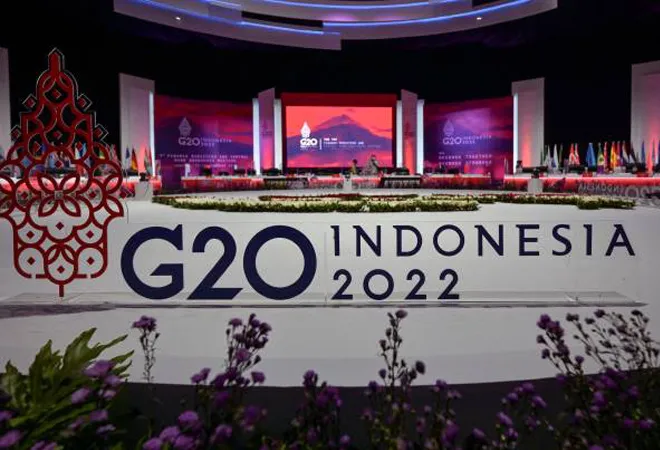
The pandemic has elevated global debt levels to new heights, beyond the stress nations were already facing before the pandemic. Nearly
60 percent of low-income countries are at high risk or already in debt distress. The global economy saw the largest one-year debt surge since World War II, with global debt rising to
US$226 trillion in 2020. According to the International Monetary Fund (IMF) Global Debt Database, the global debt rose by 28 percentage points to
256 percent of GDP in 2020. The post-pandemic blow and financing constraints faced by several low-income economies urged the G20 to set up the
Debt Service Suspension Initiative in 2020 and later, the Common Framework. In the past, there have been several umbrella debt reduction initiatives, including the Multilateral Debt Relief Initiative, Paris Club, London Club, Brady Plan, and the Heavily Indebted Poor Countries Initiative (HIPC).
The post-pandemic blow and financing constraints faced by several low-income economies urged the G20 to set up the Debt Service Suspension Initiative in 2020 and later, the Common Framework.
Whilst different initiatives had different approaches for creditor participation and conditionality, the recent programmes face a unique set of challenges and have been criticised for being inadequate in meeting the requirement of the rising debt distress. Therefore, it is crucial to examine the evolution of umbrella debt restructuring programmes and evaluate the backdrop within which the initiatives have been introduced.
Evolution of the debt treatments
The Paris Club became one of the main drivers in resolving the debt crisis after the 1980s debt crisis—there was a significant
increase in the number of annual agreements during the crisis. Following the 1980s crisis, the Paris Club saw a structural shift in its classic approach of applying the same rules to all debtor countries for short-term relief. In the late 1980s, they adopted the
Venice terms and the
Toronto terms, which provided longer deferral and repayment periods and partial cancellation of the debt to the most heavily indebted countries respectively. “
Comparability of treatment” is an important part of the Paris Club, where the creditor groups—including private creditors and non-Paris bilateral countries—are required to share the burden equally. On the other hand, the London Club enabled a group of representative banks—known as the Bank Advisory Committee—to negotiate the restructuring terms with the developing countries on behalf of all individual banks. The London Club process introduced the “
agreement in principle”, where the restructuring terms were signed in unanimity by all the banks involved, thus eliminating the need to coordinate with hundreds of individual banks.
Furthermore, in 1989, the Brady Plan was first announced by the US Treasury Secretary Nicholas Brady and was later supported by the IMF and World Bank. The
Brady Plan was set apart by its menu approach, through which the creditors were offered a menu of options for different new instruments such as discount bonds and below-market interest rates. The Plan encouraged not only short-term relief but also debt reduction to restore debtor solvency. The plan was implemented on a case-by-case basis—leading to a major policy shift in debt relief. In 1996, with the introduction of the HIPC (Heavily Indebted-Poor Countries) initiative, the debt cancellations increased, reaching almost 90 percent. Moreover, in 2005, the HIPC initiative was supplemented with the MDRI (Multilateral Debt Relief Initiative), which linked the debt relief with the structural reforms programs related to United Nations’ SDGs.
The DSSI provided the same debt treatment to all requesting countries, allowing temporary liquidity relief through suspension of debt service.
With the COVID-19 pandemic, the need for an umbrella debt relief programme was felt yet again. The DSSI led to the suspension of debt service payments from the poorest countries that requested it. Around
48 out of the 73 eligible countries sought the DSSI relief, receiving
US$12.9 billion of debt service suspension granted mainly by bilateral official lenders. The DSSI provided the same debt treatment to all requesting countries, allowing temporary liquidity relief through suspension of debt service. In 2020, the extraordinary G20 Finance Ministers and Central Bank Governor’s Meeting
recognised that support for debt relief may be required beyond Debt Service Suspension Initiative (DSSI) for nations to recover from the crisis. Consequently, the Common Framework for Debt Treatments was
proposed to address protracted liquidity and insolvency problems. As compared to the previous DSSI, the Common Framework allows debt rescheduling tailored to the specific needs of requesting countries. Furthermore, whilst the DSSI encouraged but did not require comparable debt relief from other creditors, the Common Framework requires the debtor to seek comparable relief from others including Paris Club, non-Paris Club and private creditors.
| Type of programme |
Conditionality |
Creditor Participation |
Private Sector Participation |
| Paris Club (1980s) |
Implementing a sound package of economic policies by debtor countries, resulting in restoration of creditworthiness. |
Included the ‘Comparability of Treatment’ clause where all creditors were expected to provide relief that is commensurate with their exposure to the debtor country. |
Private creditors included banks, bondholders, and suppliers. |
| London Club (1980s) |
- |
Case-by-case restructuring routine developed between major western banks and developing country governments. Included a Bank Advisory Committee (BAC) to represent the western banks. |
Creditors included major western banks. |
| Brady Plan (1989-90s) |
Debtor countries to carry out market-liberalisation in return for debt. |
The menu of options for offering grant debt relief included different debt instruments for creditors. It was implemented on a country-by-country basis. |
Private-sector creditors such as commercial banks were incentivised. |
| HIPC (mid-1990s) |
Establish a track record of good performance under programmes supported by loans from the IMF and the World Bank and implement structural reforms linked with the acceleration of the achievement of SDGs. |
Debt owed to Paris Club and Multilateral Institutions was eligible. |
Included bilateral and commercial creditors. Private sector participation was on a voluntary basis. |
| DSSI (2020) |
Use fiscal space for social, health and economic support, as monitored by IFIs. Disclose all public sector financial commitments, with technical assistance from IFIs. |
Only provides maturity extension on a uniform basis for all DSSI-eligible countries. |
Voluntary private sector participation. |
| Common Framework (2021) |
The need for debt treatment will be based on an IMF-WBG Debt Sustainability Analysis (DSA) and the participating official creditors’ collective assessment. The debtor countries will have to provide all public sector financial commitments. |
It provides debt relief through maturity extension and interest rate reduction. Offers guiding agreements on debt treatment on a case-by-case basis. Includes comparability of treatment with other creditors. |
It includes non-Paris Club members. Includes comparability of treatment with other creditors. |
Challenges for the DSSI and Common Framework
Both—the DSSI and Common Framework—were launched with the view of addressing unsustainable debts faced by countries, especially in the aftermath of the pandemic. However, the DSSI faced criticism due to limited participation of debtor countries and reporting about private-creditor participation due to the fear of facing a
credit rating downgrade. The Initiative lacked private creditor participation in the debt service suspension on equal terms. Similarly, the Common Framework had been only sought by three countries: Chad, Ethiopia, and Zambia, all of which were
delayed. Even though the Common Framework seeks comparable debt relief from all creditors, the task becomes especially challenging due to the growing creditor base diversity in emerging economies and least developed countries.
The framework has also been criticised for lacking a clear methodology for the assessment of comparable treatment for private creditors and failure to provide any incentives for their participation.
Whilst the creditor base in previous umbrella programmes predominantly consisted of Paris Club bilateral creditors, and commercial and multilateral banks, today, the creditor base has diversified to include non-Paris Club creditors and bondholders. The external debt owed to Paris Club creditors fell from
28 percent to 11 percent for DSSI-eligible countries in 2020. On the other hand, the external debt owed to non-Paris Club lenders such as China increased from
2 percent to 18 percent. Additionally, debt transparency is undermined by non-disclosure agreements and the ‘hidden debts’ of state-owned enterprises. The increasing diversity of creditor composition and complexity of debt instruments not only leads to a lack of debt transparency but also difficulty in coordination between creditors. The framework has also been
criticised for lacking a clear methodology for the assessment of comparable treatment for private creditors and failure to provide any incentives for their participation. Furthermore, the lack of transparency in debt composition by emerging economies and LDCs has given rise to the
concern of shifting the debt burden from the private sector to official creditors.
Both the DSSI and the Common Framework are crucial instruments for debt relief, however, the newer programmes need to adapt to the changing landscape of the creditor base and the increasing complexity of financial instruments. The blurred lines between private and public creditors have further increased the complexity of the current debt restructuring programmes. Thus, it is necessary to improve debt transparency by clearly defining how the growing base of private creditors including state-owned enterprises will be dealt with in the future. The G20 must seek a solution, which not only ensures fair burden-sharing between private and official creditors but also provides speedy debt resolution for countries seeking relief.
The views expressed above belong to the author(s). ORF research and analyses now available on Telegram! Click here to access our curated content — blogs, longforms and interviews.



 The pandemic has elevated global debt levels to new heights, beyond the stress nations were already facing before the pandemic. Nearly
The pandemic has elevated global debt levels to new heights, beyond the stress nations were already facing before the pandemic. Nearly  PREV
PREV


